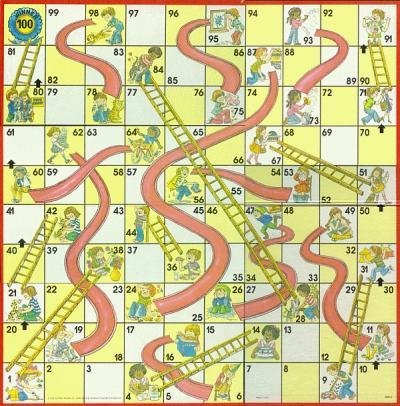One of the nice things about nerdiness becoming more of the accepted norm is that the game-playing populace is increasing, and while that means that shite games are on the rise, there's more demand than ever for good games, and for a vocal populace to recommend good games over bad ones. I've been reading through Todd Sanders' Unintentional, Sprawling,
There's a fair number of re-imaginings of existing games because, well, as with any creative work, it's easier to use existing tools in new ways than it is to come up with new tools. And everyone plays Checkers before they play Eclipse. We are capable of designing games because we understand that which we have played hitherto.
A random thought flickered into my head - Chutes and Ladders (or Snakes and Ladders, as I grew up with it) is a very well-known, rather well-loathed classic Ameritrash game. The primary criticism of the game echoes the primary criticism of Ameritrash games; there is no player agency, as the game is entirely luck dependant. You win or lose by getting lucky, not through any measure of skill or good decision-making.
Why is this so reviled of a quality? Because it's a diversion, and not an interactive one. There's not even any real interaction between players; one player's gameplay in no way helps, inhibits, or in any way influences another player's, so there's no real reason to play it with other people, except that it becomes a race between solo players. And when the game is based entirely on luck, it's a good game for gambling, but if you're not gambling, then you're mostly just watching statistics play themselves naturally out. Gambling games necessarily reward the winner; you have, in addition to the sweet intangible of victory, your stake, as well as, presumably, other people's stake. However you cut it, every game is Winner-Takes-All; Consolation Prizes don't really matter, because even if you get second place and get your bid back, someone else still got the prize you wanted. It's Winner-Takes-All.
How is a non-gambling game different? Well, you've still got the sweet intangible of victory, but when there are no stakes, the gameplay has to be more fun than winning. Yes, that's right - playing has to be, not as much, but more fun than winning. Sounds impossible, right? Because if you won, you got to play, and then win too. But the best games are so much fun to play that winning is a necessary break from further gameplay, when everyone, the winner included, groans at the end because they'd rather keep playing.
Heavy design challenge, neh? But it's true - the more you work skill into a game, the more enjoyable it is; even within gambling games, people seek out and swarm to games of chance AND skill. Blackjack. Poker. Baccarat. Games where the players get to make decisions as play develops, instead of just buying a lottery ticket. These are also games that, on a very real level, tell a story. You can come from behind in a run of Blackjack. In Keno, you either won, or you didn't. Winner Takes All.

So what in Heaven or Hell does any of this have to do with Snakes and Ladders? Well, how can I apply these musings to making it a better game? Well, I can increase the number of events, and I can make all of those events player decisions.
Let's get rid of two things; empty spaces, and that damn spinner.
First off, every space should be a chute, a ladder, or something that is not currently missing implicitly, per se, but is absent explicitly - the ability to slide forward solely within your row. We could legit have snakes, chutes, and ladders here.
(But real quick, let's liven this up - how about instead of a simple zigzag, we try it as a spiral? How does that open things up?)
I would reduce the board to an 8x8 grid, firstly so it can be playtested on a chessboard, and secondly because it would simplify a board that would become very busy if every step had an Event.
Now, to the real root of the problem - Player Agency. How do I make this a game of skill, and not chance?
Well, here's the thing - if I remove chance ENTIRELY, like, say, replacing the spinner with a set of cards that can be drafted, there's the chance (ha) that the game will inherently favour the first player or the last player, etc. Of course, I can make the BOARD random, which people seem a lot more comfortable with. So that's an option. Let's move on. How can I increase player interaction, so that it's not a solitaire race? A number of ways. If I go with the card drafting thing, then players can already block each other that way. Or, if I go another way, say, roll two dice, one after the other, with the option of "banking" a bad roll, then I could make the game cooperative - borrowing each other's banked dice, while trying to manage everyone's lives, and get the most players out of the game alive - Different difficulty levels, based on how many Snakes you can survive before your player is eliminated - or even turned.
So those are some thoughts - the primary concept )mechanic even) of Snakes and Ladders is not inherently broken - the game just suffers from features that make it undesirable as a skill game. Fixable features. Features we can turn to our advantage.
Cool, neh?
Comments
Post a Comment